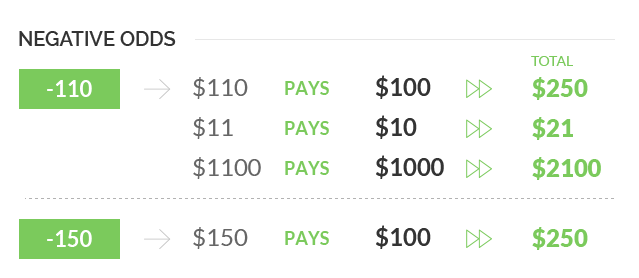Although betting odds can look confusing at first, our complete guide will make sure you have the knowledge of how they work and can make more informed choices when gambling online.
What Are Odds & How Do Odds Work in Betting: A Beginner’s Guide
Table of Contents
What are Betting Odds & How to Read Sports Odds
Knowing how to understand and calculate odds is something that anyone who is placing bets should take the time to learn. The betting odds reflect your selection’s chance of winning in the eyes of the bookmakers and how much money you stand to win if your wager is successful.
Although betting odds can look confusing at first, our complete guide will make sure you have the knowledge of how they work and can make more informed choices when gambling online.
Betting Odds and Probabilities
Betting odds are essentially a ratio of the probability that something will happen. For example, odds of 3/1 (written as “3 to 1”) means that for every 4 times the event occurs, it will happen 3 times and not occur once. This can be translated to a 25% chance of occurrence.
Similarly, odds of 1/3 (“1 to 3”) mean that out of 4 times the event occurs, it will happen only once and not occur 3 times – giving a probability of occurrence at 33%.
It is important to note that odds do not necessarily reflect the true likelihood or probability of an event occurring – they are set by bookmakers who take into account various factors such as public opinion and predicted outcomes. This means odds can change over time as more information becomes available or if the majority of bets are placed on a certain outcome.
Types of Sports Betting Odds
There are three main types of odds used in sports betting: fractional, decimal, and American. These odds all essentially mean the same thing but are presented in different formats that may be more familiar to bettors in certain regions.

Fractional odds are most commonly used by bookmakers in the UK and Ireland, with odds written as “3/1”. To calculate your potential winnings using fractional odds, you simply multiply your stake by the odds (i.e. a $10 bet at 3/1 odds would return $40),
Decimal odds are popular in continental Europe, Australia, and Canada, written as “2.50” for example. In decimal format, the number represents the total payout – including the initial stake – so a $10 bet at odds of 2.50 would give a total payout of $25 ($15 profit + initial stake).
American odds (sometimes referred to as Moneyline odds) are mainly used in the US and are written as a positive or negative number, such as +150 or -200. A negative number indicates how much needs to be staked to win $100 (e.g. odds of -200 would require a $200 stake for a potential $100 profit), while a positive number shows how much can be won from a $100 stake (i.e odds of +150 would return a profit of $150 from a $100 bet).
American Odds
In American odds, odds are presented as a positive or negative number. A negative number indicates the amount that must be bet to win $100, while a positive number shows the amount that will be won for every $100 bet. For example, odds of -120 would mean you have to bet $120 to win $100, whereas odds of +150 indicate a payout of $250 on a successful $100 wager.

Fractional (British) Odds
These odds express the potential profit in relation to the stake. So odds of 3/1 (“three-to-one”) means for every 1 unit staked, there is a potential profit of 3 units – including the returned stake. In fractional odds, the number on the left (3 in this case) is the potential profit, and the number on the right (1) is the stake.

Decimal (European) Odds
Decimal odds show the return on a 1 unit stake – including that initial stake. So odds of 4.00 indicate a potential return of 4 units for every 1 unit staked. To calculate your potential profit using decimal odds, simply multiply your stake by the odds – so for a successful $10 bet at odds of 4.00, you would receive a payout of $40 ($10 x 4.00).

Comparing Different Types of Odds
It is important to remember that odds in different formats may appear to be different values but essentially show the same probability. Comparing odds in different formats can seem complicated, but there are conversion calculators available online to make it easier.
For example, odds of -120 in American odds would be written as 1.83 in decimal odds and 6/5 in fractional odds – all expressing the same likelihood of winning.
Ultimately, it is up to personal preference which format you prefer to use. It can also depend on the sportsbook or betting platform being used, as some may only offer betting odds in certain formats.
How to Read Betting Odds
Reading odds can also involve considering the likelihood or probability of an event occurring – expressed as a percentage or in odds. Odds of 1/3 can also be expressed as a probability of 33%. This can be calculated by dividing the number on the left (1 in this case) by the sum of both numbers (1+3=4), giving odds of 1/3 as a probability of 25%.
It is important to remember that odds do not necessarily reflect the true likelihood or probability of an event occurring – they are set by bookmakers who take into account various factors such as public opinion and predicted outcomes. This means odds can change over time as more information becomes available or if the majority of bets are placed on a certain outcome.
To calculate potential profits using odds, simply multiply your stake by the odds (for decimal odds) or use the formula stake x (odds +1) for fractional odds. For American odds, positive odds show how much will be won for every $100 staked, while negative odds indicate how much must be bet to win $100.
Using Odds to Calculate Probability
It is possible to calculate the probability using odds and vice versa. For fractional odds, the calculation is simply odds / (odds + 1). So odds of 3/1 would have a probability of 25% (3/(3+1)).
For decimal odds, the calculation is 1 / odds. So odds of 4.00 have a probability of 1/4 or 25%.
And for American odds, if the odds are negative, the calculation is 100 / (odds * -1), and if they are positive, it is 100 / (odds +100). So -120 odds would have a probability of 45.45% (100/(-120+100)), and +150 odds would have a probability of 40% (100/(150+100)).
These calculations can also be used to convert odds into the different formats – for example, odds of 3/1 in fractional odds would be 4.00 in decimal odds (1 / (3/4)), and +300 in American odds (100 / (3+100)).
The important thing to remember is that odds represent the bookmakers’ assessment of the likelihood or probability of an event occurring – not necessarily the true likelihood. Odds can change over time as more information becomes available or if bets are placed heavily on one outcome. And calculating potential profits from odds simply involves multiplying your stake by the odds, or using specific formulas for different odds formats.
Summary
Odds represent the bookmaker’s assessment of the likelihood or probability of an event occurring and can change over time. They can be expressed in different formats and converted using calculations. To calculate potential profits, simply multiply your stake by the odds.
Frequently Asked Questions
What do odds +100 mean?
+100 odds indicate that for every $100 bet, you will win an additional $100 – so a successful $100 bet at odds of +100 would pay out $200.
What does +200 mean in odds?
+200 odds indicate that for every $100 bet, you will win an additional $200 – so a successful $100 bet at odds of +200 would pay out $300.
What are 8 to 1 odds?
8 to 1 odds means that for every $1 bet, you will win an additional $8 – so a successful $10 bet at odds of 8 to 1 would pay out $90.
Why would you bet on negative odds?
Some people may choose to bet on negative odds because they have information or insight that others do not – for example, insider knowledge of a team or athlete. However, it is important to remember that odds represent the bookmakers’ assessment and are not necessarily reflective of the true likelihood of an event occurring. Betting on negative odds also means risking more money in order to potentially win less. It is ultimately up to each individual’s personal preference and risk tolerance.
What sport is easiest to bet on?
There is no definitive answer to this as odds and likelihoods can vary greatly based on factors such as individual teams or athletes, injuries, weather, etc. Some may find it easier to bet on sports they are familiar with and have knowledge of, while others may prefer to conduct extensive research before placing a bet. It ultimately depends on the individual’s preferences and strategy. Additionally, different sports may offer various types of bets – some may offer more options or be more predictable in terms of odds and outcomes. Again, there is no one right answer – it is up to each person to determine what works best for them.
How can I know a winning team by odds?
Odds alone do not necessarily indicate a winning team – as mentioned before, odds represent the bookmakers’ assessment and can change over time. It is important to consider other factors such as individual team or athlete performance, injuries, weather, etc. Conducting research and using your own knowledge and insight can also be helpful in determining potential winners. Ultimately, betting involves some level of risk and there is no guarantee of a win. However, odds can be useful in helping to inform your decision-making process.


















